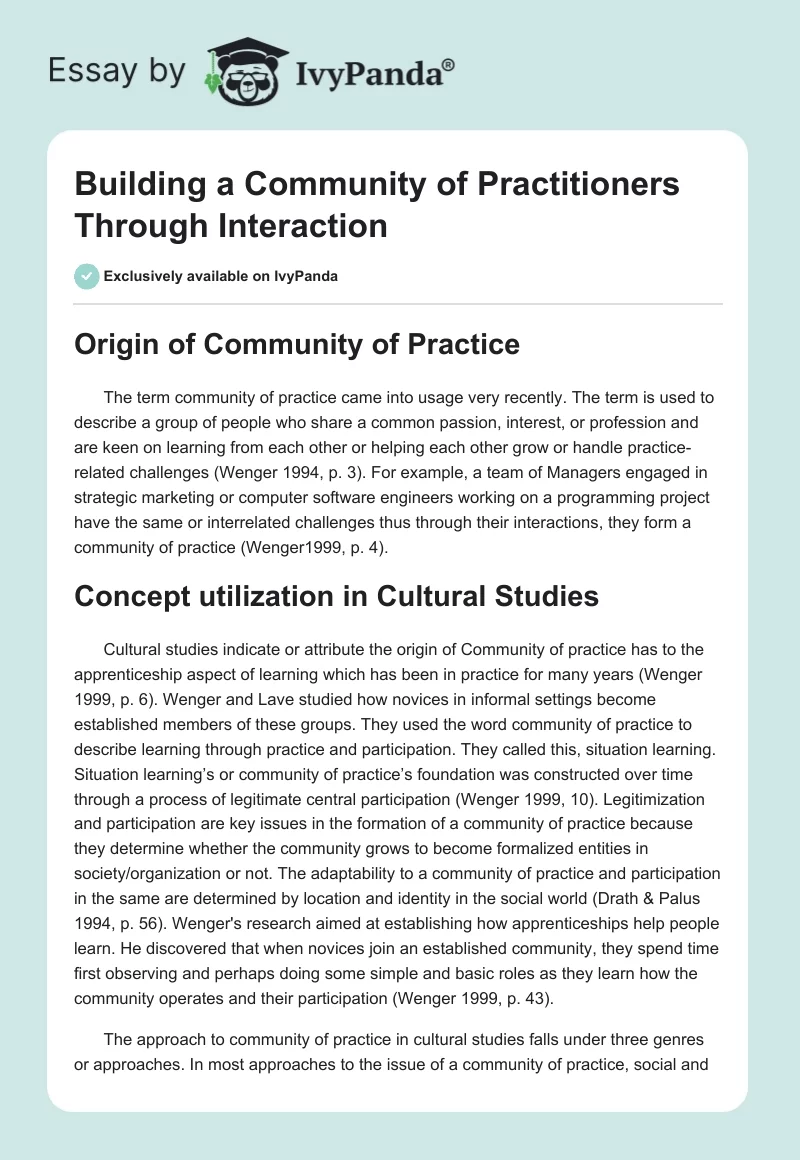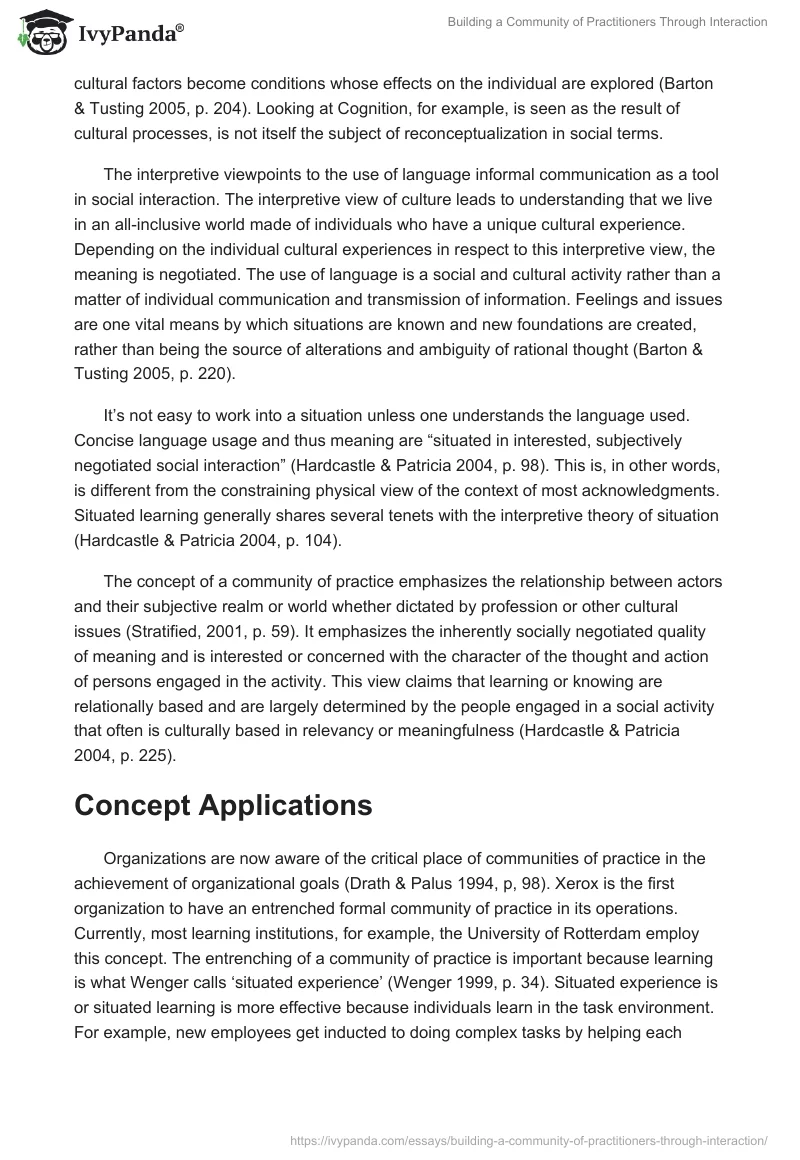Origin of Community of Practice
The term community of practice came into usage very recently. The term is used to describe a group of people who share a common passion, interest, or profession and are keen on learning from each other or helping each other grow or handle practice-related challenges (Wenger 1994, p. 3). For example, a team of Managers engaged in strategic marketing or computer software engineers working on a programming project have the same or interrelated challenges thus through their interactions, they form a community of practice (Wenger1999, p. 4).
Concept utilization in Cultural Studies
Cultural studies indicate or attribute the origin of Community of practice has to the apprenticeship aspect of learning which has been in practice for many years (Wenger 1999, p. 6). Wenger and Lave studied how novices in informal settings become established members of these groups. They used the word community of practice to describe learning through practice and participation. They called this, situation learning. Situation learning’s or community of practice’s foundation was constructed over time through a process of legitimate central participation (Wenger 1999, 10). Legitimization and participation are key issues in the formation of a community of practice because they determine whether the community grows to become formalized entities in society/organization or not. The adaptability to a community of practice and participation in the same are determined by location and identity in the social world (Drath & Palus 1994, p. 56). Wenger’s research aimed at establishing how apprenticeships help people learn. He discovered that when novices join an established community, they spend time first observing and perhaps doing some simple and basic roles as they learn how the community operates and their participation (Wenger 1999, p. 43).
The approach to community of practice in cultural studies falls under three genres or approaches. In most approaches to the issue of a community of practice, social and cultural factors become conditions whose effects on the individual are explored (Barton & Tusting 2005, p. 204). Looking at Cognition, for example, is seen as the result of cultural processes, is not itself the subject of reconceptualization in social terms.
The interpretive viewpoints to the use of language informal communication as a tool in social interaction. The interpretive view of culture leads to understanding that we live in an all-inclusive world made of individuals who have a unique cultural experience. Depending on the individual cultural experiences in respect to this interpretive view, the meaning is negotiated. The use of language is a social and cultural activity rather than a matter of individual communication and transmission of information. Feelings and issues are one vital means by which situations are known and new foundations are created, rather than being the source of alterations and ambiguity of rational thought (Barton & Tusting 2005, p. 220).
It’s not easy to work into a situation unless one understands the language used. Concise language usage and thus meaning are “situated in interested, subjectively negotiated social interaction” (Hardcastle & Patricia 2004, p. 98). This is, in other words, is different from the constraining physical view of the context of most acknowledgments. Situated learning generally shares several tenets with the interpretive theory of situation (Hardcastle & Patricia 2004, p. 104).
The concept of a community of practice emphasizes the relationship between actors and their subjective realm or world whether dictated by profession or other cultural issues (Stratified, 2001, p. 59). It emphasizes the inherently socially negotiated quality of meaning and is interested or concerned with the character of the thought and action of persons engaged in the activity. This view claims that learning or knowing are relationally based and are largely determined by the people engaged in a social activity that often is culturally based in relevancy or meaningfulness (Hardcastle & Patricia 2004, p. 225).
Concept Applications
Organizations are now aware of the critical place of communities of practice in the achievement of organizational goals (Drath & Palus 1994, p, 98). Xerox is the first organization to have an entrenched formal community of practice in its operations. Currently, most learning institutions, for example, the University of Rotterdam employ this concept. The entrenching of a community of practice is important because learning is what Wenger calls ‘situated experience’ (Wenger 1999, p. 34). Situated experience is or situated learning is more effective because individuals learn in the task environment. For example, new employees get inducted to doing complex tasks by helping each other. Situated experience or learning covers issues of “cognition, perception, language, the social world, and their interrelations balance” (Barton & Tusting 2005, p. 199).
We live in a world which is socially and culturally composed (Barton & Tusting 2005, p. 203). Knowledge in the social world is socially mediated and open-ended, it’s meaning to given actors; its furnishings and the relations to humans with and within it are produced, reproduced, and changed in the course of an activity which includes speech and thought, but cannot be reduced to one another. The community of practice has created apprenticeship in our culture. The community of practice has been a result of the emphasis on apprenticeship and doing through learning (Wenger 1999, 96). Identity in participation as a result of apprenticeship has proven its place in the society and most organizations thrive due to this practice (Wenger 1999, p. 104).
Management Paradox
Communities of practice can be very instrumental in helping organizations gain a competitive advantage (Streatified, 2001, p. 68). As Wenger and Snyder (2000, p. 140) point out, communities of practice can help drive organizational strategies, solve pertinent problems in organizations, develop professionalism, facilitate the transfer of best practices and boost general morale in an organization. In communities of practice, every aspect or detail that pertains to a task or challenge is factored into consideration. What employees would not achieve or dare do as individuals is enabled or made possible through the community of practice participation (Hardcastle & Patricia 2004, p. 201). It follows that management would benefit from the thriving of such communities of practice. However, a paradox sets in because communities of practice by their nature are informal, spontaneous, and desist outside interference (Wenger & Snyder 2000, p. 139). Despite being spontaneous and informal, communities of practice need cultivation (Wenger & Snyder 2000, p. 143). Therefore, management has a challenge because, on one hand, it should let communities of practice develop and grow on their own yet, on the other hand, management involvement could make the communities more effective.
Management can not intentionally create communities of practice. However, it can facilitate their establishment and sustain the informal networks already in place so that they thrive. To sustain and get the communities going over time, managers and all the stakeholders should identify potential communities of practice that will enhance the company’s strategic capabilities for example informal people with the ability, skills, and zeal to enhance and develop an organization’s competencies that already exist (Wenger & Snyder 2000, p. 144). The objective is to identify these groups and assist them to come together as a community of practice (Streatified 2001, p. 79).
References
Barton, D & Tusting, K 2005, Beyond Communities of Practice: Language, Power and Social Context, Cambridge University Press, Cambridge.
Drath, WH & Palus, JC 1994, Making Common Sense, Leadership as Meaning Making in a Community of Practice Centre for Creative Leadership, Center for Creative Leadership, New York.
Hardcastle, AD & Patricia, RP 2004, Community Practice: Theories and Skills for Social Workers, Oxford University Press, Oxford.
Streatified, JP 2001, The Paradox of Control In Organization, Routledge, New York.
Wenger, CE 1999, Communities of Practice: Learning, Leaning, and Identity Cambridge University Press, Cambridge.
Wenger, CE & Snyder, MW 2000, Communities of Practice: The Organizational Frontier, Harvard business Review , 2000, pp. 139 -145.


